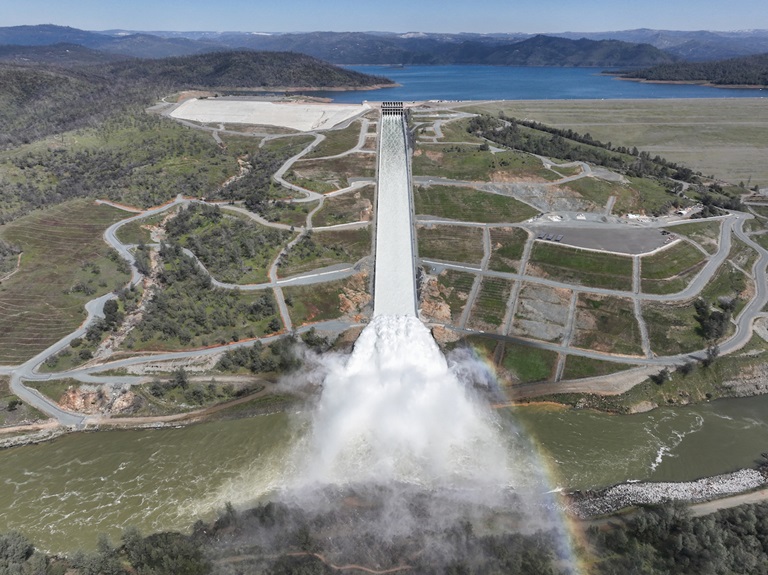How Modernizing Infrastructure Can Help to Capture More Storm Flow
A drone provides an aerial view of a cloud mist formed as water flows over the four energy dissipater blocks at the end of the Lake Oroville Main Spillway. The California Department of Water Resources increased the water release down the main spillway to 35,000 cubic feet per second (cfs). Photo taken March 17, 2023.
The series of atmospheric river storms that brought record-breaking amounts of rain and snow this year has many Californians asking if our existing water infrastructure is able to capture and store flows from these extreme weather events. With climate change resulting in stronger storms carrying more water and creating major flooding, the answer is more complicated than one might think.
“We are seeing a change in the distribution of rain and snow as climate change creates more variable weather conditions and a greater opportunity for extreme conditions,” said Department of Water Resources State Climatologist Michael Anderson. “This results in runoff patterns that can challenge historical water management operations.”
Whether it falls as rain or snow, the majority of that water flows through the Sacramento-San Joaquin Delta – the center of California’s water distribution system – on its way to the San Francisco Bay. From state and federal pumping facilities in the south Delta, water is lifted into the aqueducts that carry it to the Bay Area, Central Coast, Central Valley and Southern California, to be delivered to 27 million people and 750,000 acres of farmland.
Additionally, there are limitations to how much water can be stored and moved at any time during extreme weather events. Older infrastructure limitations, subsidence over time and regulations that govern how much water may be diverted to the aqueducts in order to protect water quality and fisheries only allow for so much water to move through the system. These regulations are also based in part on the physical location of the facilities.
The Delta Conveyance Project is an infrastructure modernization project outlined in Governor Newsom’s strategy to adapt California’s water supply for a hotter and drier future. The project is an essential climate adaptation strategy that will help adapt to climate change and aid in ensuring the State Water Project can capture, move and store water during extreme weather events like the nine atmospheric rivers experienced in January.
For example, if the Delta Conveyance Project had been operational during the high rain events of January this year, the modernized conveyance system could have moved 228,000 acre-feet of water into San Luis Reservoir while still meeting fishery and water quality protections and regulations. That’s enough water to supply about 2.3 million people for an entire year and is equivalent to approximately 40 percent of the total State Water Project exports in water year 2022.
As encouraging as the recent rainfall and snowpack statistics are, state water managers note that drought impacts persist in certain parts of the state, and it will take years to replenish groundwater basins. While the winter season has been positive, it will take more than one wet year to solve our future water supply challenges and modernizing our current infrastructure is crucial for moving and storing water during extreme rain events.
“These storms made clear the importance of our efforts to modernize our existing water infrastructure for an era of intensified drought and flood,” said DWR Director Karla Nemeth. “What we need to be positioned to do in California is move water when it’s available because moving and storing that water is going to help California weather longer and deeper droughts.”
For more information, visit the Delta Conveyance webpage.
Click here to watch an animation on State Water Project climate change vulnerabilities.
*This article was updated to reflect the approval of the project in December 2023.
